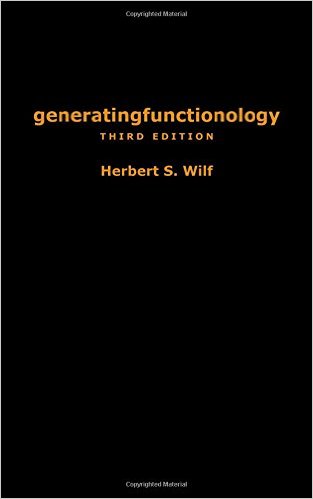
generatingfunctionology
Covers generating functions as a bridge between discrete mathematics, on the one hand, and continuous analysis (particularly complex variable theory) on the other.
Tag(s): Discrete Mathematics
Publication date: 20 Dec 2005
ISBN-10: 1568812795
ISBN-13: 9781568812793
Paperback: 192 pages
Views: 20,900
generatingfunctionology
 Covers generating functions as a bridge between discrete mathematics, on the one hand, and continuous analysis (particularly complex variable theory) on the other.
Covers generating functions as a bridge between discrete mathematics, on the one hand, and continuous analysis (particularly complex variable theory) on the other.
Publication date: 20 Dec 2005
ISBN-10: 1568812795
ISBN-13: 9781568812793
Paperback: 192 pages
Views: 20,900
Document Type: N/A
Publisher: A K Peters, Ltd.
License: n/a
Post time: 08 Jan 2007 07:06:31
Herbert S. Wilf wrote:Reproduction of the downloaded version is permitted for any valid educational purpose of an institution of learning, in which case only the reasonable costs of reproduction may be charged. Reproduction for profit or for any commercial purposes is strictly prohibited. It is not permitted for a web site other than this one to offer the book directly for downloading. Other web sites are cordially invited to link to this page, but must not take the file and offer it themselves.
Book Excerpts:
This book is about generating functions and some of their uses in discrete mathematics. The subject is so vast that there is no attempt to give a comprehensive discussion. Instead this book tries only to communicate some of the main ideas.
Generating functions are a bridge between discrete mathematics, on the one hand, and continuous analysis (particularly complex variable theory) on the other. It is possible to study them solely as tools for solving discrete problems. As such there is much that is powerful and magical in the way generating functions give unified methods for handling such problems. The reader who wished to omit the analytical parts of the subject would skip chapter 5 and portions of the earlier material. To omit those parts of the subject, however, is like listening to a stereo broadcast of, say, Beethoven’s Ninth Symphony, using only the left audio channel.
The full beauty of the subject of generating functions emerges only from tuning in on both channels: the discrete and the continuous. See how they make the solution of difference equations into child’s play. Then see how the theory of functions of a complex variable gives, virtually by inspection, the approximate size of the solution. The interplay between the two channels is vitally important for the appreciation of the music. In recent years there has been a vigorous trend in the direction of finding bijective proofs of combinatorial theorems. That is, if we want to prove that two sets have the same cardinality then we should be able to do it by exhibiting an explicit bijection between the sets. In many cases the fact that the two sets have the same cardinality was discovered in the first place by generating function arguments. Also, even though bijective arguments may be known, the generating function proofs may be shorter or more elegant.
The bijective proofs give one a certain satisfying feeling that one "really" understands why the theorem is true. The generating function arguments often give satisfying feelings of naturalness, and "oh, I could have thought of that," as well as usually offering the best route to finding exact or approximate formulas for the numbers in question.
Tweet
About The Author(s)
Herbert Wilf (1931-2012) was the University of Pennsylvania Thomas A. Scott Emeritus Professor of Mathematics. He was the author of six books and more than 160 research articles. From the 1950's, he was a pioneer in the mathematical programming of early computers, beginning with his work at Nuclear Development Associates, which led to his book Mathematical Methods for Digital Computers, written with A. Ralston. His early work focused on numerical analysis and complex analysis, and led to numerous research papers as well as a textbook, Mathematics for the Physical Sciences.
.jpg)
Herbert Wilf (1931-2012) was the University of Pennsylvania Thomas A. Scott Emeritus Professor of Mathematics. He was the author of six books and more than 160 research articles. From the 1950's, he was a pioneer in the mathematical programming of early computers, beginning with his work at Nuclear Development Associates, which led to his book Mathematical Methods for Digital Computers, written with A. Ralston. His early work focused on numerical analysis and complex analysis, and led to numerous research papers as well as a textbook, Mathematics for the Physical Sciences.